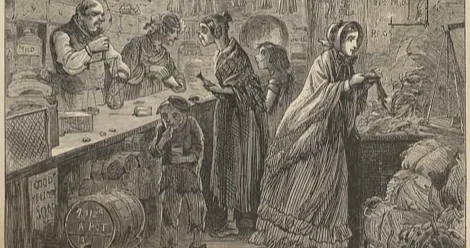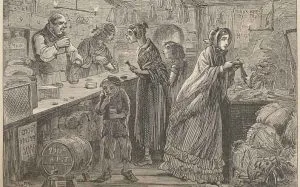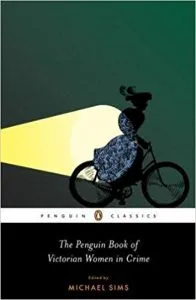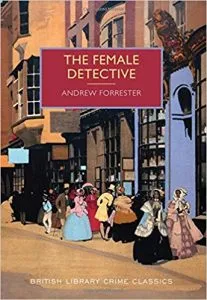
Step Aside, Sherlock! Women Were Cracking Cases in Victorian England, Too
This content contains affiliate links. When you buy through these links, we may earn an affiliate commission.
To celebrate the birthday of Arthur Conan Doyle, we’re writing about all things Sherlockian/ACD today. This piece on Victorian female detectives is sponsored by The 7 ½ Deaths of Evelyn Hardcastle by Stuart Turton.
 The most inventive debut of 2018, this clever, mind-bending murder mystery will leave readers guessing until the very last page.
One of Stylist Magazine’s 20 Must-Read Books of 2018.
One of Harper’s Bazaar’s 10 Must-Read Books of 2018.
One of Marie Claire, Australia’s 10 Books You Absolutely Have to Read in 2018
At a gala party thrown by her parents, Evelyn Hardcastle will be killed. Again. She’s been murdered hundreds of times, and each day, Aiden Bishop is too late to save her. Doomed to repeat the same day over and over, Aiden’s only escape is to solve Evelyn Hardcastle’s murder. However nothing and no one are quite what they seem.
The most inventive debut of 2018, this clever, mind-bending murder mystery will leave readers guessing until the very last page.
One of Stylist Magazine’s 20 Must-Read Books of 2018.
One of Harper’s Bazaar’s 10 Must-Read Books of 2018.
One of Marie Claire, Australia’s 10 Books You Absolutely Have to Read in 2018
At a gala party thrown by her parents, Evelyn Hardcastle will be killed. Again. She’s been murdered hundreds of times, and each day, Aiden Bishop is too late to save her. Doomed to repeat the same day over and over, Aiden’s only escape is to solve Evelyn Hardcastle’s murder. However nothing and no one are quite what they seem.
“Criminals are both masculine and feminine—indeed, my experience tells me that when a woman becomes a criminal she is far worse than the average of her male companions, and therefore it follows that the necessary detectives should be of both sexes.” —Miss Gladden, The Female Detective
the first women detectives
Wilkie Collins’s Anne Rodway in “The Diary of Anne Rodway” was one of the first female detectives in literature, amateur or otherwise. But unlike Sherlock Holmes, Anne falls into solving a mystery after her friend dies under suspicious circumstances. When the police seem to be bungling the case and are unwilling to listen to what she has to say, Anne takes matters into her own hands. Take that, patriarchy!
Then came Andrew Forrester’s Miss Gladden (or “G”), though we as readers are never really sure if this is her true name, and in fact a lot of details about G’s life are concealed from us. Her personal identity is not the point of the stories; the point is the mystery. Forrester’s Miss Gladden short stories have been collected in The Female Detective—originally published in 1864 and rereleased for contemporary readers just recently in 2016.
Later, in 1888, Mr. Bazalgette’s Agent by Leonard Merrick became the first British novel to feature a female detective. Like Collins’s Anne Rodway, Merrick’s protagonist Miriam Lee only becomes a detective because her situation forces her to do so. Having fallen on hard times, Lea answers Mr. Bazalgette’s ad for a private detective, and she then finds herself on a journey across the world in search of “an audacious fraudster.”
 The British Library has been doing a lot of great work reprinting these once forgotten female detective stories in their British Library Crime Classics series. If you love Sherlock Holmes and are dying to read more Victorian detective fiction, featuring either male or female detectives, you should check out the British Library’s catalogue.
If you’re looking specifically for more women detectives, some more from the time period include Mrs. Paschal from Revelations of a Lady Detective by W.S. Hayward. Then there’s Dora Myrl: Lady Detective by M. McDonnell Bodkin. One of my personal favorites is actress-turned-detective Dorcas Dene, whose stories can be read in Dorcas Dene, Detective: The Complete Adventures by George Robert Sims.
I was hard-pressed to find British female detective stories written by British women, but across the pond in the United States, author Anna Katherine Green was writing influential detective fiction featuring women in the late 19th century/early 20th century. Three of Green’s novels (which have been collected into one volume called The Amelia Butterworth Mysteries) feature the character Amelia Butterworth, who would later become the prototype for famous lady detectives like Agatha Christie’s Miss Marple and Patricia Wentworth’s Miss Silver. Green also created “girl detective” genre with her debutante-turned-secret sleuth character featured in The Golden Slipper and Other Problems for Violet Strange.
Some of these women’s stories and others are collected in The Penguin Book of Victorian Women in Crime, edited by Michael Sims, and there is also a section of women detective stories in The Rivals of Sherlock Holmes, edited by Stefan Dziemianowicz.
So on this very sacred holiday that is Arthur Conan Doyle Day, I’m not telling you to forget your favorite Sherlock Holmes stories. I’m simply pointing out that it might be worth making some room on your bookshelf next to your Holmes tomes for some of these Victorian female detectives.
The British Library has been doing a lot of great work reprinting these once forgotten female detective stories in their British Library Crime Classics series. If you love Sherlock Holmes and are dying to read more Victorian detective fiction, featuring either male or female detectives, you should check out the British Library’s catalogue.
If you’re looking specifically for more women detectives, some more from the time period include Mrs. Paschal from Revelations of a Lady Detective by W.S. Hayward. Then there’s Dora Myrl: Lady Detective by M. McDonnell Bodkin. One of my personal favorites is actress-turned-detective Dorcas Dene, whose stories can be read in Dorcas Dene, Detective: The Complete Adventures by George Robert Sims.
I was hard-pressed to find British female detective stories written by British women, but across the pond in the United States, author Anna Katherine Green was writing influential detective fiction featuring women in the late 19th century/early 20th century. Three of Green’s novels (which have been collected into one volume called The Amelia Butterworth Mysteries) feature the character Amelia Butterworth, who would later become the prototype for famous lady detectives like Agatha Christie’s Miss Marple and Patricia Wentworth’s Miss Silver. Green also created “girl detective” genre with her debutante-turned-secret sleuth character featured in The Golden Slipper and Other Problems for Violet Strange.
Some of these women’s stories and others are collected in The Penguin Book of Victorian Women in Crime, edited by Michael Sims, and there is also a section of women detective stories in The Rivals of Sherlock Holmes, edited by Stefan Dziemianowicz.
So on this very sacred holiday that is Arthur Conan Doyle Day, I’m not telling you to forget your favorite Sherlock Holmes stories. I’m simply pointing out that it might be worth making some room on your bookshelf next to your Holmes tomes for some of these Victorian female detectives.
 The most inventive debut of 2018, this clever, mind-bending murder mystery will leave readers guessing until the very last page.
One of Stylist Magazine’s 20 Must-Read Books of 2018.
One of Harper’s Bazaar’s 10 Must-Read Books of 2018.
One of Marie Claire, Australia’s 10 Books You Absolutely Have to Read in 2018
At a gala party thrown by her parents, Evelyn Hardcastle will be killed. Again. She’s been murdered hundreds of times, and each day, Aiden Bishop is too late to save her. Doomed to repeat the same day over and over, Aiden’s only escape is to solve Evelyn Hardcastle’s murder. However nothing and no one are quite what they seem.
The most inventive debut of 2018, this clever, mind-bending murder mystery will leave readers guessing until the very last page.
One of Stylist Magazine’s 20 Must-Read Books of 2018.
One of Harper’s Bazaar’s 10 Must-Read Books of 2018.
One of Marie Claire, Australia’s 10 Books You Absolutely Have to Read in 2018
At a gala party thrown by her parents, Evelyn Hardcastle will be killed. Again. She’s been murdered hundreds of times, and each day, Aiden Bishop is too late to save her. Doomed to repeat the same day over and over, Aiden’s only escape is to solve Evelyn Hardcastle’s murder. However nothing and no one are quite what they seem.
“Criminals are both masculine and feminine—indeed, my experience tells me that when a woman becomes a criminal she is far worse than the average of her male companions, and therefore it follows that the necessary detectives should be of both sexes.” —Miss Gladden, The Female Detective

From Wilkie Collins’s “The Diary of Anne Rodway”
the victorian female detective
On Arthur Conan Doyle Day, it’s important for us to take a moment to recognize the tireless hours of detective work, the genius discoveries, and the lives made better by women detectives in 19th century British literature. Sure, Arthur Conan Doyle is the creator of famous literary male detective Sherlock Holmes, whose name has become synonymous with the author himself, and I don’t mean to divert attention away from the work of the man of the hour (Sherlock Holmes and/or Arthur Conan Doyle, take your pick). Except maybe I do a little bit, because women detectives were also getting the job done back in Victorian England, right alongside Sherlock Holmes, and I’d like to explore why they don’t get the same amount of recognition as Holmes, and why they deserve more! Although women weren’t allowed to enter the police force in the UK until around the time of World War I, there were female private detectives in the UK in the late 1800s, around the same time Sherlock Holmes was galavanting around London, solving mysteries. And even before that, authors were writing women detectives, of both the amateur and professional variety, into their fictions.the first women detectives

Wilkie Collins’s Anne Rodway in “The Diary of Anne Rodway” was one of the first female detectives in literature, amateur or otherwise. But unlike Sherlock Holmes, Anne falls into solving a mystery after her friend dies under suspicious circumstances. When the police seem to be bungling the case and are unwilling to listen to what she has to say, Anne takes matters into her own hands. Take that, patriarchy!
Then came Andrew Forrester’s Miss Gladden (or “G”), though we as readers are never really sure if this is her true name, and in fact a lot of details about G’s life are concealed from us. Her personal identity is not the point of the stories; the point is the mystery. Forrester’s Miss Gladden short stories have been collected in The Female Detective—originally published in 1864 and rereleased for contemporary readers just recently in 2016.
Later, in 1888, Mr. Bazalgette’s Agent by Leonard Merrick became the first British novel to feature a female detective. Like Collins’s Anne Rodway, Merrick’s protagonist Miriam Lee only becomes a detective because her situation forces her to do so. Having fallen on hard times, Lea answers Mr. Bazalgette’s ad for a private detective, and she then finds herself on a journey across the world in search of “an audacious fraudster.”
why female detectives Matter
We can learn a lot about gender roles and expectations of the Victorian time period by comparing these female detective narratives to those of Holmes. Unlike Sherlock Holmes, who is kept at a distance from the reader through the curious narrator and onlooker/participant character of Watson, many of the female detectives mentioned in this article speak directly to the reader, often narrating their own stories through diaries or letters, forms of writing that were more suitable for women at the time and that are traditionally seen as much more emotional and intimate than a published story narrated by an outsider or in the third person. Furthermore, the female detective of the Victorian era is often forced into her investigation because of outside forces beyond her control. This is likely because detective work, and really any work in the public sphere, was not considered ladylike, and authors felt it necessary to explain how their women characters fell into such work. In his introduction to The Female Detective, Mike Ashley writes that even now “there is a residual belief that women are inherently more endowed than men are with qualities of sympathy and care…the woman detective is [therefore] somehow slumming when she ventures into a criminal world that is dominated by crude, unsympathetic, and cruel men.” Perhaps it is this ethic of care that women are supposedly naturally endowed with that makes female detectives feel more intrinsically connected to the victims of crimes than Sherlock Holmes traditionally is. One of Holmes’s defining characteristics is his emotional distance from the crimes he investigates, which helps him come at the crime with a logical and detached mind. Female detectives of the same period are often more attached. This could also have to do with the fact that women are traditionally the victims of crimes in these narratives, and thus women who are used to being objectified and victimized are going to have a different perspective on violence and crime. That, too, is what can make female detective fiction so empowering, however: this idea that these women who are usually the victim can flip the narrative, fight for themselves, and get justice on their own terms. We can also learn a lot about gender norms by looking at the limitations placed on women in detective fiction. Even in a place of empowerment, women detectives were not on the same footing as their male counterparts. In her book The Woman Detective: Gender and Genre, Kathleen Klein argues that women detectives exist outside of societal norms, and this is what makes their existence so problematic for the detective genre, which is so bent on returning life to normalcy by the end of the narrative. Klein explains that the female detective’s “presence pushes off-center the whole male/female, public/private, intellect/emotion, physical strength/weakness dichotomy. Therefore, her façade of normal respectability—like the criminal’s—must be stripped away.” By the end of the story, the woman detective is often taken down a peg or two, and/or she is sent back to her domestic sphere. In the case of Wilkie Collins’s Anne Rodway, for instance, the amateur sleuth’s fiancé shows up to take care of the dirty work after the mystery is solved, and in the end, Anne and her fiancé get married. This need for a return to normalcy in traditional detective fiction might be why, to this day, female detectives are the exception of the drama rather than the rule. So how about we give more love to the lady detectives, and make them more of the norm?Further Reading on Victorian Female Detectives
 The British Library has been doing a lot of great work reprinting these once forgotten female detective stories in their British Library Crime Classics series. If you love Sherlock Holmes and are dying to read more Victorian detective fiction, featuring either male or female detectives, you should check out the British Library’s catalogue.
If you’re looking specifically for more women detectives, some more from the time period include Mrs. Paschal from Revelations of a Lady Detective by W.S. Hayward. Then there’s Dora Myrl: Lady Detective by M. McDonnell Bodkin. One of my personal favorites is actress-turned-detective Dorcas Dene, whose stories can be read in Dorcas Dene, Detective: The Complete Adventures by George Robert Sims.
I was hard-pressed to find British female detective stories written by British women, but across the pond in the United States, author Anna Katherine Green was writing influential detective fiction featuring women in the late 19th century/early 20th century. Three of Green’s novels (which have been collected into one volume called The Amelia Butterworth Mysteries) feature the character Amelia Butterworth, who would later become the prototype for famous lady detectives like Agatha Christie’s Miss Marple and Patricia Wentworth’s Miss Silver. Green also created “girl detective” genre with her debutante-turned-secret sleuth character featured in The Golden Slipper and Other Problems for Violet Strange.
Some of these women’s stories and others are collected in The Penguin Book of Victorian Women in Crime, edited by Michael Sims, and there is also a section of women detective stories in The Rivals of Sherlock Holmes, edited by Stefan Dziemianowicz.
So on this very sacred holiday that is Arthur Conan Doyle Day, I’m not telling you to forget your favorite Sherlock Holmes stories. I’m simply pointing out that it might be worth making some room on your bookshelf next to your Holmes tomes for some of these Victorian female detectives.
The British Library has been doing a lot of great work reprinting these once forgotten female detective stories in their British Library Crime Classics series. If you love Sherlock Holmes and are dying to read more Victorian detective fiction, featuring either male or female detectives, you should check out the British Library’s catalogue.
If you’re looking specifically for more women detectives, some more from the time period include Mrs. Paschal from Revelations of a Lady Detective by W.S. Hayward. Then there’s Dora Myrl: Lady Detective by M. McDonnell Bodkin. One of my personal favorites is actress-turned-detective Dorcas Dene, whose stories can be read in Dorcas Dene, Detective: The Complete Adventures by George Robert Sims.
I was hard-pressed to find British female detective stories written by British women, but across the pond in the United States, author Anna Katherine Green was writing influential detective fiction featuring women in the late 19th century/early 20th century. Three of Green’s novels (which have been collected into one volume called The Amelia Butterworth Mysteries) feature the character Amelia Butterworth, who would later become the prototype for famous lady detectives like Agatha Christie’s Miss Marple and Patricia Wentworth’s Miss Silver. Green also created “girl detective” genre with her debutante-turned-secret sleuth character featured in The Golden Slipper and Other Problems for Violet Strange.
Some of these women’s stories and others are collected in The Penguin Book of Victorian Women in Crime, edited by Michael Sims, and there is also a section of women detective stories in The Rivals of Sherlock Holmes, edited by Stefan Dziemianowicz.
So on this very sacred holiday that is Arthur Conan Doyle Day, I’m not telling you to forget your favorite Sherlock Holmes stories. I’m simply pointing out that it might be worth making some room on your bookshelf next to your Holmes tomes for some of these Victorian female detectives.- Who Owns Sherlock Holmes?
- 12 Mystery Novels for Fans of Literary Fiction
- My Dear Holmes and Watson: 3 Books Featuring Dynamic Duos
- Quiz: Which Secondary Sherlock Holmes Character Are You?
- Sherlock Holmes or Nero Wolfe: Which Literary Detective Do You Prefer?
- 10 Fascinating Women in the Sherlock Holmes Canon (Who Aren’t Irene Adler)
- Arthur Conan Doyle, Spiritualism, and Fairies
- 5 Speculative Fiction Takes on Sherlock Holmes
- Maintaining the Brain-Attic: Sherlock Holmes’s Mental Health











